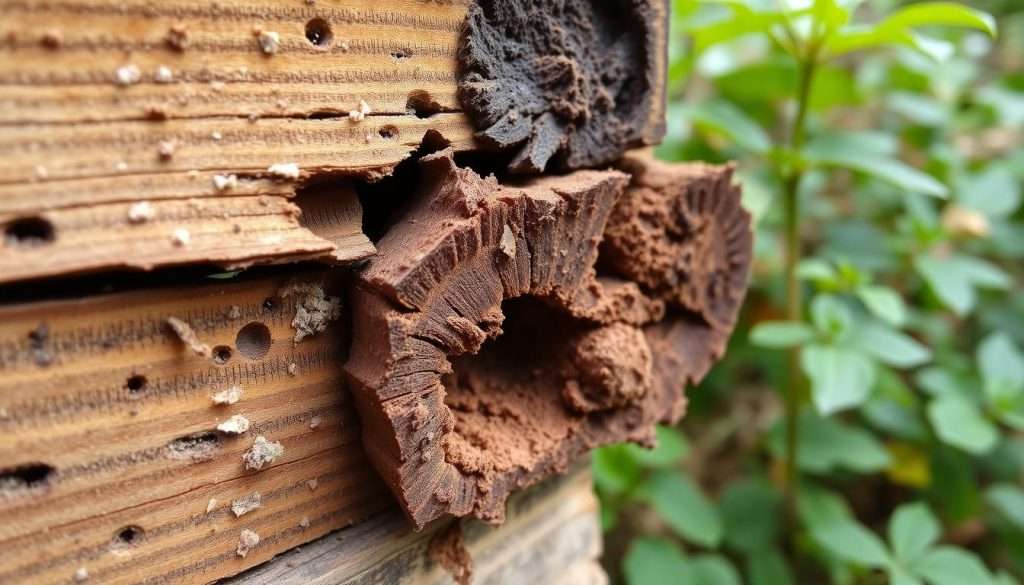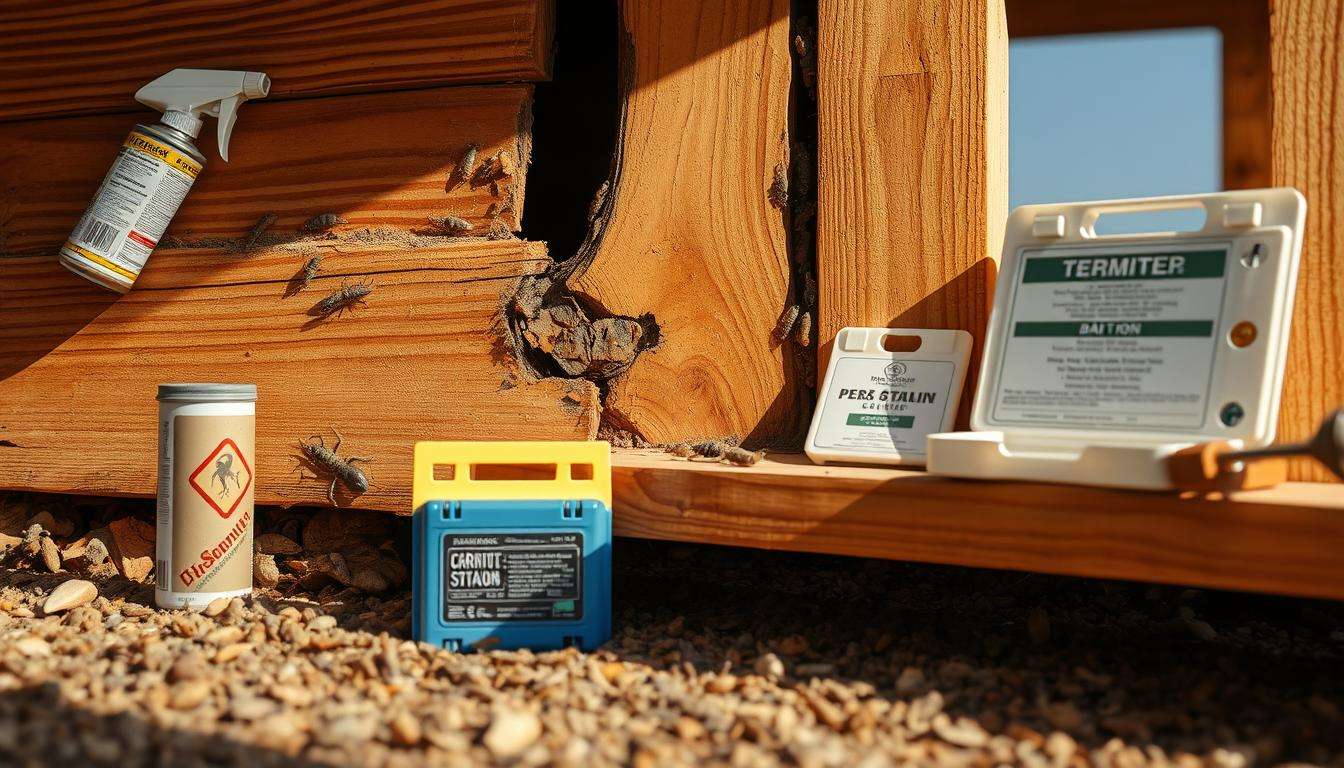Dealing with termites can feel overwhelming. Yet, it’s crucial to tackle these “silent destroyers” before they damage your home. These pests cause significant and costly damage, often before you notice them.
This guide is for homeowners and DIY enthusiasts. It provides essential information on treating termites. We’ll cover how to identify them, treatment options, prevention strategies, and repair methods. This ensures you can protect your property.
For a full understanding of termite treatment methods, keep reading. We’ll dive into the world of termite control and extermination.
Key Takeaways
- Timely recognition of termite signs is essential for effective termite control.
- Professional inspection can significantly enhance your chances of effective termite extermination.
- Liquid termiticide often provides long-lasting results, up to 12 years, making it a popular choice.
- Prevention strategies can save you from costly damages in the long run.
- Regular maintenance and inspections are key in avoiding future infestations.
- Foam treatments help reach hard-to-access areas and are effective against certain species.
- Understanding different treatment methods is vital for informed decision-making.
Understanding Termites and Their Impact
Termites are important in nature but can harm homes. Knowing about termites and their damage is key for homeowners. These pests eat wood and live in groups.
Different Types of Termites:
In the U.S., there are subterranean, drywood, and dampwood termites. Each type is different:
- Subterranean Termites: These live underground and use mud tubes to get to wood. They cause most damage.
- Drywood Termites: Found in southern California, they live in wood. They need special treatments like fumigation.
- Dampwood Termites: They like wet places and are found near the coast.
Termite colonies can be small or have millions of termites. In places like North Carolina, they swarm from late winter to fall.
The Economic Cost of Termite Damage:
Termite damage costs over $2 billion a year in the U.S. Homeowners need to watch for signs to avoid damage. Look for:
- Sawdust-like piles near wood
- Dirt or mud tubes on walls
- Darkening or blistering of wood
Without action, termite damage can grow for years. Knowing this helps homeowners protect their homes from termites.
| Type of Termite | Habitat | Common Damage | Control Method |
|---|---|---|---|
| Subterranean | Underground | Severe wood damage | Mud tubes, liquid insecticides |
| Drywood | Inside wood structures | Framing, furniture | Fumigation, heating |
| Dampwood | Moist areas, coastal | Wood decay | Localized treatments |
Identifying Signs of Termite Infestation
It’s key to spot termite signs early to avoid damage. Termites can cost a lot, over $5 billion a year in the U.S. Knowing the signs helps homeowners act fast to stop big problems.
Common Indicators:
- Mud tubes: Subterranean termites make mud tubes to reach wood. Seeing these tubes means termites are around.
- Discarded wings: After mating, swarmers drop their wings. Finding these near doors or windows means termites might be coming.
- Hollow-sounding wood: Wood that sounds hollow when tapped has termites inside.
- Frass: Drywood termites leave wood-colored droppings, or frass, that look like small pellets.
- Odd-shaped mud formations: Formosan termites build unique mud structures on walls, showing they’re there.
- Dried mud spots: Pin holes and dried mud on walls or ceilings mean termites are active.
Why Early Detection is Crucial:
Finding termites early is very important. They hide until they’re many and cause damage. Spotting signs like mud tubes or frass means you can get help fast.
Experts can check for damage and find the best way to treat it. Waiting too long can make the problem worse. So, acting quickly is very important.

How to Treat Termites Effectively
Effective termite treatment starts with a detailed check by experts. They can see how bad the problem is. Using professional termite services helps a lot. DIY methods might not work well for a long time.
Professional Inspection Services:
Getting a professional to check for termites has many benefits:
- Experts can find where termites live, even 18 inches underground.
- They use special tools to watch for termites.
- They make sure to treat every part of the nest.
DIY vs. Professional Treatment Options:
There are two ways to treat termites:
- DIY solutions: These are things you can buy at stores. They might help a little, but they don’t solve the big problem.
- Professional treatments: These include soil treatments, wood injections, and gas fumigation. They get rid of termites better and more completely.
Popular Treatment Methods:
It’s important to know about different ways to treat termites:
- Soil Treatment: This is when termiticides are put around and under buildings. It stops termites from coming back.
- Bait Systems: These can be used alone or with other treatments. They target where termites are most active.
- Wood Treatment: This is when stuff is put into wood to keep termites out. It might need more treatments, like for floors.
Choosing the best termite treatment and using professional services can protect your home. This keeps termites away for good.
Termite Treatment Methods
It’s important to know about termite treatment methods for good pest control. You can choose from chemical treatments, bait systems, and wood treatments. Each method works differently and is best for certain types of termites and infestations.
Chemical Treatments:
Chemical treatments are a key way to fight termites. Homeowners often use soil fumigants and termiticides. These create barriers or kill termites. Products like Termidor® and Altriset make a liquid barrier under the soil, protecting against subterranean termites.
There are different ways to apply these treatments:
- Surface application for visible infestations
- Soil injection for subterranean termite control
- Direct wood injection for treating drywood termites
Bait Systems for Termite Control:
Bait systems are a smart way to manage termites. They involve placing bait stations around your property. The Sentricon® with Always Active™ system has shown great results over 15 years.
Termites eat the bait and carry it back to their colonies. This helps kill more termites and can get rid of the whole colony.
Wood Treatment Options:
Wood treatments can also protect against termites. You can use:
- Pressure-treated wood that is resistant to termites
- Borate treatments that go into the wood to keep termites away
- Fumigation or heat treatment for termites in wood structures
It’s important to check and maintain treated wood regularly. This helps keep your home safe from termites.
Preventing Future Termite Infestations
Stopping termites before they start is key to keeping your home safe. Homeowners can lower the chance of termites by fixing weak spots and using the right building methods. This helps keep your home termite-free.
Effective Preventative Measures:
- Regular Inspections: Get your home checked for termites every year to catch problems early.
- Moisture Control: Fix leaks and bad drainage to keep termites away.
- Wood-to-Ground Contact: Keep wood away from the ground to block termite paths.
- Sealing Cracks: Seal holes around pipes to stop termites from getting in.
- Habitat Reduction: Get rid of dead trees and wood piles to cut down on termite homes.
Construction Practices for Termite Prevention:
- Termite-Resistant Materials: Choose materials that termites can’t damage when building.
- Physical Barriers: Use metal mesh or treated wood to guard your foundation.
- Ventilation: Make sure crawl spaces have good air flow to keep moisture down.
- Soil Treatment: Treat soil around your home with termiticides for extra protection.
- Monitoring Stations: Use stations to warn you of termites, but they’re not a full fix.
Repairing Termite Damage
After a termite infestation, fixing the damage quickly is key. First, check the damage to wood, floors, and furniture. This step helps plan how to fix the termite damage.
Assessing the Extent of Damage:
Look at all wood for termite signs. Check places like:
- Crawl spaces
- Decks
- Wall voids
- High-moisture areas
- Woodpiles
Knowing how much damage is done is very important. Some termites can damage wood in just two years. Getting regular checks from experts can save you a lot of money.
Restoration Options:
After checking the damage, think about how to fix it. You might choose to:
| Restoration Option | Description | Skill Level Required |
|---|---|---|
| Replace Damaged Sections | Take out and put in new wood where it’s badly damaged. | Expert carpentry needed. |
| Add Wood Support | Put in wood next to weak spots to make it stronger. | Moderate skill level. |
| Temporary Support Systems | Use temporary supports to keep things stable while you fix them. | Basic construction knowledge. |
Fixing termite damage can be hard, especially for big or outside wood parts. Homeowners should get help from licensed exterminators and skilled contractors. This ensures the damage is fixed right and the termites are gone for good.

Conclusion
Knowing how to treat termites is key for homeowners. Understanding signs of infestation and available solutions helps you act fast. Regular checks and upkeep are the first steps to prevent damage.
Termites can harm your home a lot, especially wood and cellulose items. They cause billions of dollars in damage worldwide each year. Knowing how to stop them is very important.
If you find termites in your home, act quickly. Learn about prevention or get help from experts. For more tips, check out how to treat termites on professional websites.
